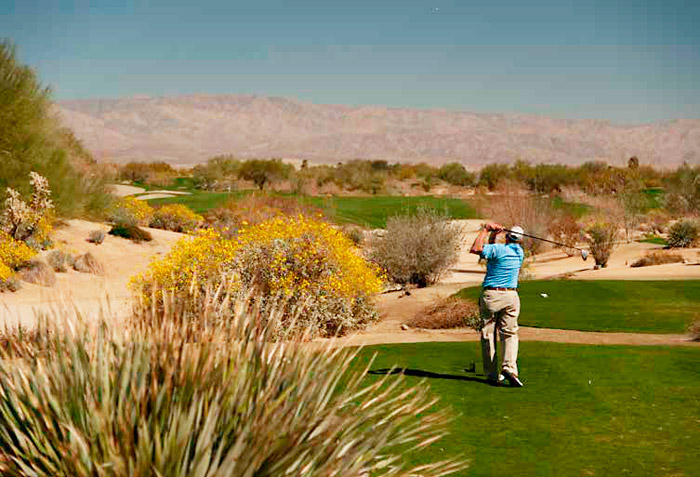Landscape

Landscape (non-play) areas are an essential part of the overall course design, providing enhanced course aesthetics, wildlife habitat, external sound/noise abatement, and natural cooling and freeze protection.
An environmental landscape design approach addresses environmentally safe and energy-saving practices; therefore, environmentally sound landscape management is also economically important. Non-play areas require a mix of sun and shade, optimal soil conditions and adequate canopy air movement to sustain growth and function.
Species Selection and Size Considerations
Principles
- The fundamental principle for the environmentally sound management of landscapes is “right plant, right place.” The ideal plant from an environmental standpoint is the one that nature and evolution placed there. It has adapted specifically to the soil, microclimate, rainfall, and light patterns, insects, and other pests, and endemic nutrient levels over thousands of years.
- Know the ultimate sizes and growth rates of trees, shrubs, and ground covers. This reduces the need for pruning and debris removal and lowers maintenance costs.
- The addition of proper soil amendments can improve soil’s physical and chemical properties, increase its water-holding capacity, and reduce the leaching of fertilizers. Amendments may be organic or inorganic; however, soil microorganisms rapidly decompose organic amendments such as peat or compost.
- The goal of species-selection BMP is to maintain as close to a natural ecosystem as practical, while meeting the needs of a golf course.
- Landscape areas should be fundamentally designed to facilitate rapid plant establishment to conserve water and lower nutritional input requirements once mature. Plants within areas that are not in play or are not critical to the design of the course may be removed and replanted with native plant material that requires little to no maintenance after establishment. Additionally, 50% to 70% of the non-play areas should remain in natural cover. As much natural vegetation as possible should be retained and enhanced through the supplemental planting of native trees, shrubs, and herbaceous vegetation to provide wildlife habitat in non-play areas, along water sources to support fish and other water-dependent species. By leaving dead trees (snags) where they do not pose a hazard, a well-developed understory (brush and young trees), and native grasses, the amount of work needed to prepare a course is reduced while habitat for wildlife survival is maintained.
Best Management Practices
- Base plant selection as close to a natural ecosystem as practical, while meeting the needs of the golf course. It has adapted specifically to the soil, microclimate, rainfall, light patterns, insects and other pests, and endemic nutrient levels over many years.
- Select trees, plants, and grass species to attract birds seeking wild fruits, herbs, seeds, and insects.
- Know the ultimate sizes and growth rates of trees, shrubs, and ground covers.
- Use plants that are adapted for the site based on the United States Department of Agriculture (USDA) cold-hardiness map.
- Select stress-tolerant species or cultivars to manage periodic dry/wet conditions.
- Choose the most stress-tolerant species or cultivar for a particular area.
Design and Function
Principles
- Aesthetic gardens, window boxes, and container gardens should include a variety of plants of different heights that provide nectar for hummingbirds and butterflies. Again, “right plant, right place” is the key to success.
- When integrating turf areas into the landscape around the clubhouse, entries, and other areas, design them for ease of maintenance and keep in mind that turfgrasses grow best in sunny areas. Consider the effect that tree canopy and other design features may have on the health and function of the turf.
- Garden plants, shrubbery, ground covers, or native plants may provide a pleasing view as well as provide useful food, cover, or other environmental benefits to wildlife; they may also require reduced maintenance.
- Trees and shrubs along streams provide temperature moderation through shade, which lowers water temperature in summer and increases it in winter.
Best Management Practices
- Well-designed forested buffers should contain a mixture of fast- and slow-growing native trees, shrubs, and grasses to provide a diverse habitat for wildlife.
- Use forested buffers to trap and remove upland sources of sediments, nutrients, and chemicals.
- Use forested buffers to protect fish and wildlife by supplying food, cover, and shade.
- Use forested buffers to maintain a healthy riparian ecosystem and stable stream channel.
- Leave dead tree snags whenever possible for nesting and food source to wildlife. However, make sure that these snags are a safe distance away from playing surfaces should they get blown over.
- Use turf as a landscape element where needed.
Planting Methods
Principles
- The ideal plant from an environmental standpoint is the one that nature and evolution placed there. It has adapted specifically to the soil, microclimate, rainfall, light patterns, insects, and other pests, and endemic nutrient levels over hundreds or thousands of generations. Where these factors have changed, the challenge is finding other suitable plants. A BMP goal is to maintain as close to a natural ecosystem as practical, while meeting the needs of the golf course.
- The use of organic mulches in gardens and aesthetic areas increases the moisture-holding capacity of plantings and prevents weed growth when applied in sufficient depth. Organic amendments are decomposed by soil microorganisms and add to soil tilth.
- Keep mulch 2 to 3 inches away from plants, to prevent fungal growth from excess dampness.
- Excess mulch or compacted mulch may be detrimental, causing water to shed away from the root zone and encourage overwatering. Compaction or excessive mulch buildup should be avoided, especially when annual re-mulching is performed.
Best Management Practices
- The plant palette and irrigation system should be appropriate for site conditions, taking into account that, in some cases, soil improvement can enhance water-use efficiency.
- Plants should be grouped together based on irrigation demand.
- The percentage of landscaped area in irrigated high-water-use hydrozones should be minimized. Local government ordinances should address the percentage of irrigated landscaped area that may be included in high-water-use hydrozones. These high water-use limits should not apply to landscaped areas requiring large amounts of turf for their primary functions (for example, ball fields and playgrounds).
- In most instances, established, drought-tolerant landscape plants have a root system substantial enough to keep them alive with little or no supplemental irrigation.
- Pruning and fertilizing will also benefit landscape plants while they are becoming established.
- Add proper soil amendments in garden areas to improve the soil’s physical and chemical properties, increase its water-holding capacity, and reduce the leaching of fertilizers.





